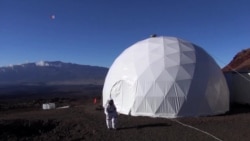For generations, people have dreamed of traveling to Mars to explore our closest planetary neighbor. While space agencies like NASA are planning manned missions to the planet, some volunteers in Hawaii are learning how humans will cope with months in isolation on a Mars base.
Volunteers are living for eight months in terrain that looks much like the surface of Mars. Six people are isolated high atop Mauna Loa, a volcanic mountain on the Big Island of Hawaii in a make-believe Mars base. The project, funded by NASA, is called HI-SEAS, which stands for Hawaii Space Exploration Analog and Simulation.
Kim Binsted of the University of Hawaii is principal investigator. She walks across the red lava rock and says this stark setting, 2,500 meters above sea level, is as close to Mars as you will find on Earth.
“Visually, it is very similar to what you see on Mars. You will see that there is really no visible plant life, there is no visible animal life," she said. "And you have got this wonderful volcanic material. We are on a cinder cone here on Mauna Loa. Mauna Loa is geologically very similar to Olympus Mons on Mars.”
Mauna Loa is the second largest mountain in the solar system, after the Martian peak, when measured from its base.
The six-member crew inside is mostly self-sufficient. Support crews bring food and supplies, but cannot interact with volunteers inside the habitat.
Binsted says this is an experiment that looks at the interaction of astronauts.
“We study how well they work together, how we can keep them happy and supported, and not wanting to kill each other over these long durations,” she said.
The current crew has been living in the habitat since October and will stay until June. Two earlier crews have gone before them.
Participants communicate with the outside world through email and blogs and even YouTube videos.
This is not the only group of volunteers with sights set on Mars. An organization called Mars One, based in The Netherlands, has solicited applications for would-be Mars astronauts from around the world.
Others believe the American or European space agencies are more likely to reach the goal, in the 2030s, or later. Whoever gets there first, the journey will not be easy, says Kim Binsted.
“It is going to be challenging,” she said.
In the meantime, volunteers are getting a taste of life on a future Mars base.










